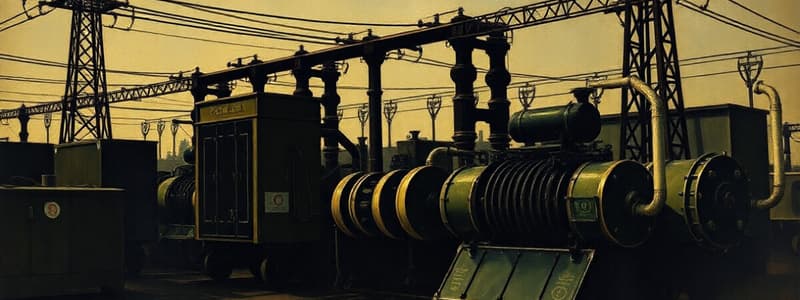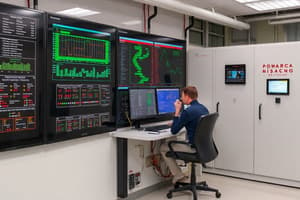Podcast
Questions and Answers
What is the primary function of the Load Frequency Control (LFC) in a power system?
What is the primary function of the Load Frequency Control (LFC) in a power system?
- To regulate the reactive power and voltage magnitude.
- To control the real power and frequency. (correct)
- To manage the mechanical power of the turbine.
- To adjust the steam valve position in response to load changes.
If a generator's electrical load suddenly increases, what is the immediate source of the additional power?
If a generator's electrical load suddenly increases, what is the immediate source of the additional power?
- Increased electrical power from AVR.
- Increased mechanical power from the turbine.
- Increased input from the governor model.
- Kinetic energy stored in the rotating system. (correct)
What does the parameter 'D' in the load model represent?
What does the parameter 'D' in the load model represent?
- The change in mechanical power output.
- The change in steam valve position.
- The change in motor speed.
- The percent change in load divided by percent change in frequency. (correct)
In the context of a power system, what does the term 'Δw' represent?
In the context of a power system, what does the term 'Δw' represent?
Which of the following best describes the immediate effect of an increased electrical load on the turbine speed and generator frequency?
Which of the following best describes the immediate effect of an increased electrical load on the turbine speed and generator frequency?
What is the characteristic polynomial equation derived from the given open-loop transfer function?
What is the characteristic polynomial equation derived from the given open-loop transfer function?
According to the Routh-Hurwitz criterion, what condition must be met for control system stability, given a positive value of K?
According to the Routh-Hurwitz criterion, what condition must be met for control system stability, given a positive value of K?
At what point does the root locus cross the vertical axis in the s-plane?
At what point does the root locus cross the vertical axis in the s-plane?
What is the approximate value of K calculated using the magnitude condition at the point where the root locus crosses the vertical axis?
What is the approximate value of K calculated using the magnitude condition at the point where the root locus crosses the vertical axis?
What is the approximate governor speed regulation (R) value calculated using the value of K?
What is the approximate governor speed regulation (R) value calculated using the value of K?
What is the steady-state frequency deviation (in hertz) due to a sudden application of a 50MW load?
What is the steady-state frequency deviation (in hertz) due to a sudden application of a 50MW load?
Which of the following would be the correct representation of the closed loop transfer function of the system?
Which of the following would be the correct representation of the closed loop transfer function of the system?
What is the final value of the system's step response, according to its plot?
What is the final value of the system's step response, according to its plot?
What is the role of the turbine governor in a power system?
What is the role of the turbine governor in a power system?
In the load frequency control block diagram, what does ( \Delta P_g ) represent?
In the load frequency control block diagram, what does ( \Delta P_g ) represent?
What is the significance of the closed-loop transfer function relating the load change ( \Delta P_L ) to the frequency deviation ( \Delta \omega )?
What is the significance of the closed-loop transfer function relating the load change ( \Delta P_L ) to the frequency deviation ( \Delta \omega )?
If the frequency sensitive load (D) is zero, what primarily determines the steady-state deviation in frequency?
If the frequency sensitive load (D) is zero, what primarily determines the steady-state deviation in frequency?
What is the main function of the Routh-Hurwitz array in the given example?
What is the main function of the Routh-Hurwitz array in the given example?
In the example, the load varies by 0.8 percent for a 1 percent change in frequency. What does the value D=0.8 represent?
In the example, the load varies by 0.8 percent for a 1 percent change in frequency. What does the value D=0.8 represent?
In the example, if a sudden load change of 50 MW occurs, and the turbine is rated at 250 MW, what is the per-unit change in load expressed as ( \Delta P_L )?
In the example, if a sudden load change of 50 MW occurs, and the turbine is rated at 250 MW, what is the per-unit change in load expressed as ( \Delta P_L )?
If several generators with speed regulations ( R_1, R_2, ..., R_n ) are connected to the system, how is the steady-state deviation in frequency determined?
If several generators with speed regulations ( R_1, R_2, ..., R_n ) are connected to the system, how is the steady-state deviation in frequency determined?
Flashcards
What is LFC?
What is LFC?
Load Frequency Control (LFC) is a system that automatically adjusts the output of power generators to maintain frequency and real power balance in an electrical grid.
What is AVR?
What is AVR?
Automatic Voltage Regulator (AVR) is a system that controls the voltage output of a power generator by adjusting the excitation current.
What is the Generation Model?
What is the Generation Model?
It represents the relationship between the mechanical power input to a generator (Pm) and the electrical power output (Pe), with angular velocity (w) as the key factor.
How do motor loads respond to frequency changes?
How do motor loads respond to frequency changes?
Signup and view all the flashcards
What is the prime mover model?
What is the prime mover model?
Signup and view all the flashcards
Load Frequency Control (LFC)
Load Frequency Control (LFC)
Signup and view all the flashcards
Turbine Time Constant (tT)
Turbine Time Constant (tT)
Signup and view all the flashcards
Governor Speed Regulation (R)
Governor Speed Regulation (R)
Signup and view all the flashcards
Governor Time Constant (tg)
Governor Time Constant (tg)
Signup and view all the flashcards
Generator Inertia Constant (H)
Generator Inertia Constant (H)
Signup and view all the flashcards
Frequency Sensitive Load (D)
Frequency Sensitive Load (D)
Signup and view all the flashcards
Steady-State Frequency Deviation (Δw)
Steady-State Frequency Deviation (Δw)
Signup and view all the flashcards
Routh-Hurwitz Array
Routh-Hurwitz Array
Signup and view all the flashcards
Routh-Hurwitz Stability Criterion
Routh-Hurwitz Stability Criterion
Signup and view all the flashcards
Open-Loop Transfer Function
Open-Loop Transfer Function
Signup and view all the flashcards
Closed-Loop Transfer Function
Closed-Loop Transfer Function
Signup and view all the flashcards
Characteristic Equation
Characteristic Equation
Signup and view all the flashcards
Root Locus
Root Locus
Signup and view all the flashcards
Magnitude Condition
Magnitude Condition
Signup and view all the flashcards
Study Notes
Power System Control
- Power systems require control to maintain stable real power and frequency, as well as voltage magnitude.
- Basic Generator Control Loops:
- Load Frequency Control (LFC): Controls real power and frequency.
- Automatic Voltage Regulator (AVR): Regulates reactive power and voltage magnitude.
Generation Model
- A simplified model shows the relationship between changes in mechanical power (ΔPm) and changes in frequency (Δω).
- The transfer function is shown as: Δω(s) = (ΔPm(s) - ΔPe(s))/2Hs.
Load Model
- Motor loads react to frequency changes.
- The change in load (ΔP) is determined by the sum of a frequency-insensitive load (APL) and a change in frequency-sensitive load (DΔω).
Prime Mover Model
- The turbine model describes mechanical power output (ΔPm) changes in relation to steam valve position (ΔPv).
- The transfer function is Gr(s) = (ΔPm(s))/(ΔPv(s)) = 1 / (1 + Trs).
- The time constant (Tr) is typically between 0.2 and 2.0 seconds.
Governor Model
- When electrical load increases exceeding mechanical power, the rotating system's kinetic energy compensates for the difference
- The governor adjusts turbine input valves to restore speed and frequency to a new steady state—in response to changes in speed detected.
Speed Governing System
- A block diagram represents the speed governing system for a steam turbine.,
- Key relationship: ΔP = ΔPref – 1/R Δω
Load Frequency Control
- The complete block diagram shows the interrelation of governor, turbine, rotating mass, and load.
- Transfer function in terms of frequency change & overall load: ΔΩ(s)/-ΔPL(s) = (1 + Tgs)(1 + Trs) /((2Hs + D)(1+Tgs)(1 + Trs) + 1/R)
Stability Analysis
- Routh–Hurwitz criterion used for evaluating stability of control systems.,
- Matlab used to find stability with root locus plots.,
- System's characteristic polynomial determined and then analyzed.
- Parameter values like turbine time constant (τT), governor time constant (τg), generator inertia (H), and speed regulation (R) significantly impact the stability and performance of LFC.
Steady-State Frequency Deviation
- Steady-state frequency deviation in response to load changes calculated using the system's transfer function.
- Deviation affects parallel generators with speed-governed systems.
- Single and multi-machine systems modeled and evaluated.
Step Response
- Time domain plots and performance specifications obtained using Matlab.
- Step response and time domain performance specifications assist in evaluating the system's efficiency and stability.
- Specific examples involving parameter values, load variations, calculated frequency deviations and step responses presented.
Studying That Suits You
Use AI to generate personalized quizzes and flashcards to suit your learning preferences.




